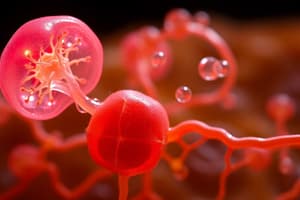Podcast
Questions and Answers
What limits the maximum size of a single cell?
What limits the maximum size of a single cell?
- Surface area to volume ratio (correct)
- Cellular division rate
- Nutrient concentration in the environment
- Diffusion distance
Which evolutionary theory suggests that multicellularity evolved from a group of identical cells functioning together?
Which evolutionary theory suggests that multicellularity evolved from a group of identical cells functioning together?
- Symbiotic Theory
- Prokaryotic Theory
- Colonial Theory (correct)
- Syncytial Theory
What advantage does multicellularity provide in terms of nutrient transport?
What advantage does multicellularity provide in terms of nutrient transport?
- Decreased surface area
- Improved efficiency in nutrient supply (correct)
- Increased cell size
- Higher metabolic rate
In what type of organisms is the Syncytial Theory most commonly observed?
In what type of organisms is the Syncytial Theory most commonly observed?
What is a key characteristic of Gonium mentioned in the description?
What is a key characteristic of Gonium mentioned in the description?
What aspect of cellular organization is primarily enhanced in multicellular organisms?
What aspect of cellular organization is primarily enhanced in multicellular organisms?
What distinguishes the Eudorina species in terms of cell specialization?
What distinguishes the Eudorina species in terms of cell specialization?
Which statement is true regarding the advantages of multicellularity?
Which statement is true regarding the advantages of multicellularity?
What is the primary disadvantage of multicellular organisms when it comes to evolution?
What is the primary disadvantage of multicellular organisms when it comes to evolution?
How do multicellular organisms improve nutrient transport effectively?
How do multicellular organisms improve nutrient transport effectively?
Flashcards
Multicellularity Evolution
Multicellularity Evolution
The process by which single-celled organisms evolved into multicellular organisms.
Surface Area to Volume Ratio
Surface Area to Volume Ratio
The ratio of a cell's surface area to its volume. Smaller cells have a higher ratio, allowing for efficient diffusion.
Protists to Multicellularity
Protists to Multicellularity
Multicellular organisms may have evolved from protists, single-celled eukaryotes.
Colonial Theory
Colonial Theory
Signup and view all the flashcards
Division of Labor
Division of Labor
Signup and view all the flashcards
Volvocine Series
Volvocine Series
Signup and view all the flashcards
Isogamy
Isogamy
Signup and view all the flashcards
Heterogamy
Heterogamy
Signup and view all the flashcards
Diffusion
Diffusion
Signup and view all the flashcards
Geometric Solutions
Geometric Solutions
Signup and view all the flashcards
Study Notes
Learning Objectives
- Describe how multicellular forms may have evolved from protists
- Evaluate the advantages and disadvantages of multicellularity
The Problem of Size
- All animals need to exchange substances with their environment
- This exchange occurs via diffusion, influenced by surface area, differences in concentration, and distance.
- Small organisms like bacteria have a large surface area to volume ratio, enabling efficient exchange via diffusion.
- Larger organisms, like whales, have a much smaller surface area to volume ratio, making diffusion inefficient over large distances.
- This limits the maximum size single-celled organisms can reach.
- Organisms larger than this size limit are multicellular.
Cell Size and Microscopy
- A diagram displays various sizes of biological components, ranging from atoms to macroscopic organisms, alongside the corresponding microscopy techniques
- Different types of microscopes have varying magnification capabilities to view different sizes of biological specimens from atoms to simple cells to organisms.
Surface Area to Volume Ratio
- The surface area to volume ratio decreases as a cell grows larger
- This is critical for cell function, as exchange of substances relies on the cell's surface.
Solving the SA:V Problem
- Strategies to overcome the limitations of diffusion in larger organisms:
- Avoidance
- Geometric solutions (increase surface area through folding or branching)
- Decrease the effective cell volume
- Increase rate of supply by increasing concentration of nutrients
- Optimize nutrient transport within or between cells
- Improve efficiency to reduce demand by specialization of cells and division of labour within and between cells
Evolution of Multicellularity
- Multicellularity evolved multiple times in eukaryotes
- There are three main theories: Symbiotic, Syncytial, and Colonial
- Symbiotic Theory: involves different species interacting
- Syncytial Theory: occurs in multinucleated cells
- Colonial Theory: one species involved
Examples of Multicellular Development (Volvocine Algae)
- Detailed descriptions of various stages of multicellular colonial algae, including Chlamydomonas, Gonium, Pandorina, Eudorina, Pleodorina, and Volvox.
- Characteristics of each stage, such as colony size, cell specialization, type of reproduction (isogamy, anisogamy, or oogamy), and other features
Advantages of Multicellularity
- Increased size of the organism
- Cell specialization
- Increased surface area to volume ratio
Problems of Multicellularity
- Interdependence of cells for survival
- Complexity of coordinated function
Summary of Evolutionary Changes
- Unicellular to colonial life
- Increase in the number of cells in colonies
- Change in shape of colonies
- Increased interdependence among vegetative cells
- Increased division and specialization among cells
- Transitions in reproduction from isogamy to anisogamy to oogamy
- Fewer female gametes in later stages
Types of Reproduction
- Isogamy: Involves the fusion of similar-sized gametes
- Anisogamy: Involves the fusion of dissimilar-sized gametes
- Oogamy: Involves the fusion of a large, non-motile egg with a small, motile sperm
Summary of Multicellularity
- Key stages in multicellularity evolution are highlighted, with timelines of development, showing growth from simple single-celled organisms into complex multicellular colonies with intercellular cooperation.
- Key changes include modulations in cell number, cell attachments, organismal polarity, partial inversions, basal body rotation, and incomplete cytokinesis in a variety of multicellular algae.
Studying That Suits You
Use AI to generate personalized quizzes and flashcards to suit your learning preferences.




